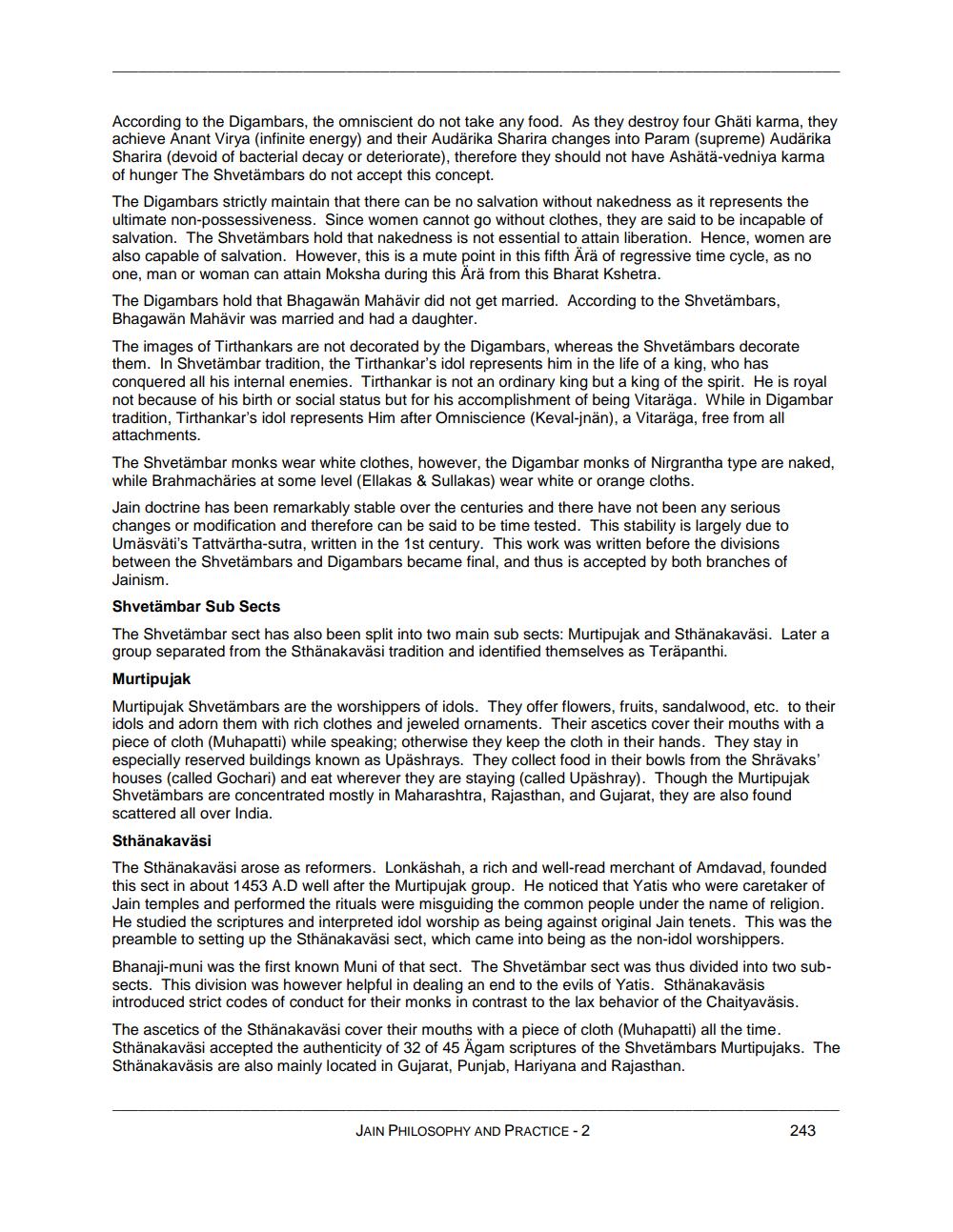________________
According to the Digambars, the omniscient do not take any food. As they destroy four Ghäti karma, they achieve Anant Virya (infinite energy) and their Audärika Sharira changes into Param (supreme) Audärika Sharira (devoid of bacterial decay or deteriorate), therefore they should not have Ashätä-vedniya karma of hunger The Shvetämbars do not accept this concept. The Digambars strictly maintain that there can be no salvation without nakedness as it represents the ultimate non possessiveness. Since women cannot go without clothes, they are said to be incapable of salvation. The Shvetämbars hold that nakedness is not essential to attain liberation. Hence, women are also capable of salvation. However, this is a mute point in this fifth Arä of regressive time cycle, as no one, man or woman can attain Moksha during this Arä from this Bharat Kshetra. The Digambars hold that Bhagawan Mahävir did not get married. According to the Shvetämbars, Bhagawan Mahävir was married and had a daughter. The images of Tirthankars are not decorated by the Digambars, whereas the Shvetämbars decorate them. In Shvetämbar tradition, the Tirthankar's idol represents him in the life of a king, who has conquered all his internal enemies. Tirthankar is not an ordinary king but a king of the spirit. He is royal not because of his birth or social status but for his accomplishment of being Vitaraga. While in Digambar tradition, Tirthankar's idol represents Him after Omniscience (Keval-inän), a Vitaraga, free from all attachments. The Shvetämbar monks wear white clothes, however, the Digambar monks of Nirgrantha type are naked, while Brahmacharies at some level (Ellakas & Sullakas) wear white or orange cloths. Jain doctrine has been remarkably stable over the centuries and there have not been any serious changes or modification and therefore can be said to be time tested. This stability is largely due to Umäsväti's Tattvärtha-sutra, written in the 1st century. This work was written before the divisions between the Shvetämbars and Digambars became final, and thus is accepted by both branches of Jainism. Shvetämbar Sub Sects The Shvetämbar sect has also been split into two main sub sects: Murtipujak and Sthänakaväsi. Later a group separated from the Sthänakaväsi tradition and identified themselves as Teräpanthi. Murtipujak Murtipujak Shvetämbars are the worshippers of idols. They offer flowers, fruits, sandalwood, etc. to their idols and adorn them with rich clothes and jeweled ornaments. Their ascetics cover their mouths with a piece of cloth (Muhapatti) while speaking; otherwise they keep the cloth in their hands. They stay in especially reserved buildings known as Upäshrays. They collect food in their bowls from the Shrävaks' houses (called Gochari) and eat wherever they are staying (called Upäshray). Though the Murtipujak Shvetämbars are concentrated mostly in Maharashtra, Rajasthan, and Gujarat, they are also found scattered all over India. Sthänakaväsi The Sthänakaväsi arose as reformers. Lonkäshah, a rich and well-read merchant of Amdavad, founded this sect in about 1453 A.D well after the Murtipujak group. He noticed that Yatis who were caretaker of Jain temples and performed the rituals were misguiding the common people under the name of religion. He studied the scriptures and interpreted idol worship as being against original Jain tenets. This was the preamble to setting up the Sthänakaväsi sect, which came into being as the non-idol worshippers. Bhanaji-muni was the first known Muni of that sect. The Shvetämbar sect was thus divided into two subsects. This division was however helpful in dealing an end to the evils of Yatis. Sthänakaväsis introduced strict codes of conduct for their monks in contrast to the lax behavior of the Chaityaväsis. The ascetics of the Sthänakaväsi cover their mouths with a piece of cloth (Muhapatti) all the time. Sthänakaväsi accepted the authenticity of 32 of 45 Agam scriptures of the Shvetämbars Murtipujaks. The Sthänakaväsis are also mainly located in Gujarat, Punjab, Hariyana and Rajasthan.
JAIN PHILOSOPHY AND PRACTICE - 2
243




